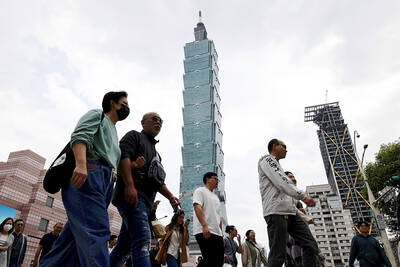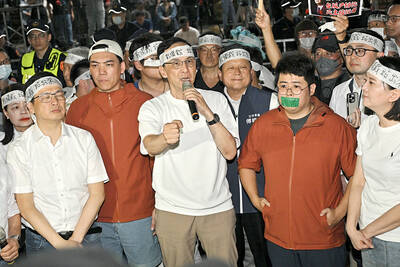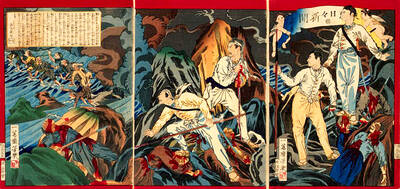Richard Rogers may be one of the greatest living architects, but he is far less well known than the buildings he designs. The Pompidou Center, Millennium Dome and Lloyd’s of London are among the more iconic structures that testify to Rogers’ unique vision. A retrospective exhibit at the Taipei Fine Arts Museum, Richard Rogers + Architects: From the House to the City offers a comprehensive look at the architect’s career over the past 40 years.
“It’s nice to know that although we’ve toured the exhibition, this is the grandest space so far. The smallest space was London,” Ivan Harbour, a partner at Rogers’ architectural firm Rogers Stirk Harbour + Partners, quipped at a preview of the show.
Rogers, who missed the opening due to the death of a close friend, works and lives in London. Harbour and Graham Stirk were on hand to introduce the exhibit.
“We’ve been working in Taiwan for about 10 years now. We’ve built two modest buildings in Kaohsiung and been involved in many competitions — all of which we’ve lost,” Harbour said.
Harbour’s self-deprecating humor corresponds with Rogers’ approach to architecture, which is both playful and human-centered. Underlying the levity, however, is a concern “with the processes of construction and the way that people relate to the buildings around them.” It is an ethos that they’ve applied to this show.
Each of the nine thematic areas — Early Work, Transparent, Lightweight, Legible, Green, Public, Systems, Urban and Work in Progress — offer visitors a grounding in the ideas that inform Rogers’ approach to architecture. Together they include 78 new and archive models, 80 drawings, 160 photographs, 22 videos and a timeline illustrating the development of Rogers’ architectural practice. Arranged in easily digestible color-coded blocks, there are designs of airports, galleries, courts and government buildings, as well as housing projects, each accompanied with explanations of materials used and purpose of construction.
The two Kaohsiung-based buildings Harbour alluded to illustrate Rogers’ ideas of space and how buildings should suit the environment within which they are erected.
The Ching Fu Group Headquarters (慶富船運大樓) with its exposed columns and primary color finishings recalls the Pompidou Center, but here with the addition of external glass boxes that serve as meeting rooms and offer views of the harbor. Built between 2005 and 2007, the self-cooling structure is an example of the kind of energy-saving building ideally suited for Taiwan’s climate.
Whereas the Ching Fu building emphasizes environmental concerns, the R9 Central Park Station (捷運R9中央公園站) on the Kaohsiung MRT’s red line exemplifies Rogers’ belief that a building should fit fluidly within its surroundings.
The design merges the concourse with the surrounding landscape, enabling the station to seamlessly unite with the expansive greenery of the park. A 50m-by-50m aluminum canopy lets natural light in while reflecting the sun’s glare and protecting passengers from the rain.
Remarking candidly at the press conference on Rogers’ comprehensive approach to architecture, Christine Skinner, outgoing director of the British Council, said the Taipei City Government could learn a thing or two from the exhibit.
“There are parts of Taipei that have obviously been developed in a holistic way,” she said referring to Xinyi (信義) and Neihu (內湖) districts.
“But there are other parts of Taipei where that planning is not happening and buildings are conceived one by one ... [Y]ou do get a feeling that not a lot of urban planning has gone on and I think that is something that Taipei in particular needs to put right,” she said.

In the March 9 edition of the Taipei Times a piece by Ninon Godefroy ran with the headine “The quiet, gentle rhythm of Taiwan.” It started with the line “Taiwan is a small, humble place. There is no Eiffel Tower, no pyramids — no singular attraction that draws the world’s attention.” I laughed out loud at that. This was out of no disrespect for the author or the piece, which made some interesting analogies and good points about how both Din Tai Fung’s and Taiwan Semiconductor Manufacturing Co’s (TSMC, 台積電) meticulous attention to detail and quality are not quite up to

April 21 to April 27 Hsieh Er’s (謝娥) political fortunes were rising fast after she got out of jail and joined the Chinese Nationalist Party (KMT) in December 1945. Not only did she hold key positions in various committees, she was elected the only woman on the Taipei City Council and headed to Nanjing in 1946 as the sole Taiwanese female representative to the National Constituent Assembly. With the support of first lady Soong May-ling (宋美齡), she started the Taipei Women’s Association and Taiwan Provincial Women’s Association, where she

Chinese Nationalist Party (KMT) Chairman Eric Chu (朱立倫) hatched a bold plan to charge forward and seize the initiative when he held a protest in front of the Taipei City Prosecutors’ Office. Though risky, because illegal, its success would help tackle at least six problems facing both himself and the KMT. What he did not see coming was Taipei Mayor Chiang Wan-an (將萬安) tripping him up out of the gate. In spite of Chu being the most consequential and successful KMT chairman since the early 2010s — arguably saving the party from financial ruin and restoring its electoral viability —

It is one of the more remarkable facts of Taiwan history that it was never occupied or claimed by any of the numerous kingdoms of southern China — Han or otherwise — that lay just across the water from it. None of their brilliant ministers ever discovered that Taiwan was a “core interest” of the state whose annexation was “inevitable.” As Paul Kua notes in an excellent monograph laying out how the Portuguese gave Taiwan the name “Formosa,” the first Europeans to express an interest in occupying Taiwan were the Spanish. Tonio Andrade in his seminal work, How Taiwan Became Chinese,